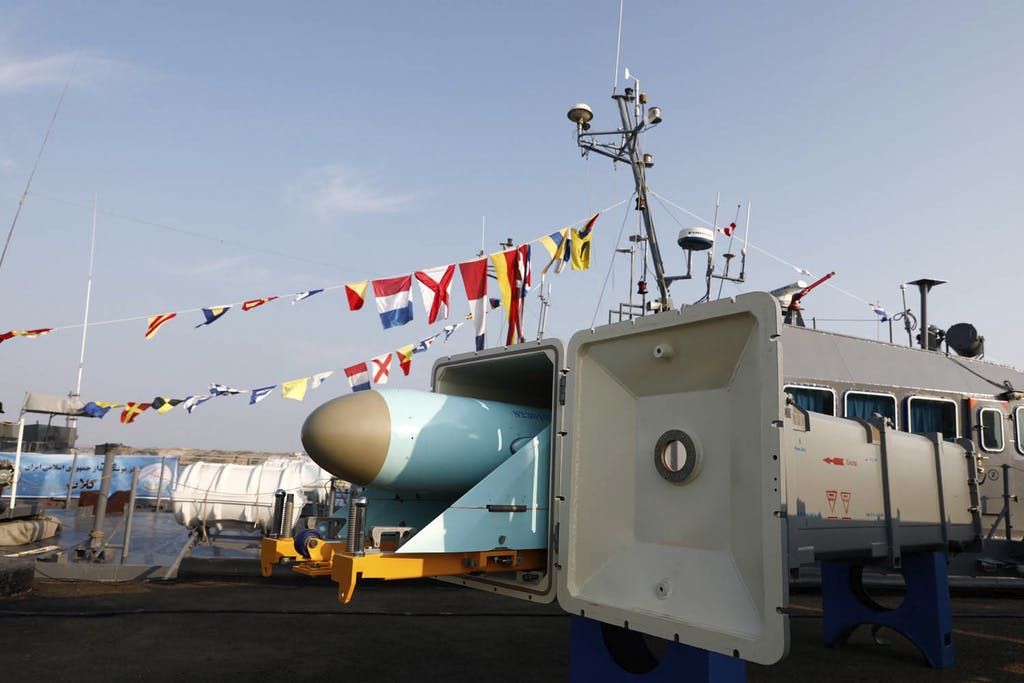Danger of a Hot War With Iran Comes Into View as Calendar Turns to 2024
The International Atomic Energy Agency warns of a reversal in the ayatollah’s enrichment of uranium.

Much to President Biden’s chagrin, 2024 is in line to be the year that America’s delicate dance around the Islamic Republic of Iran and its proxies gives way to a hot war. That’s not a certainty, but it’s certainly a possibility.
Mr. Biden has long attempted to negotiate a nuclear deal with Tehran’s wily diplomats as he maintains the Iran policies of his former boss, President Obama. The policy of ignoring Tehran’s regional aggression in the hope of halting Iran’s nuclear race seems out of fashion now, as the International Atomic Energy Agency issues a dire new report.
Iran “increased its production of highly enriched uranium, reversing a previous output reduction from mid-2023,” the IAEA said Tuesday in a statement. The Iranians now have enough uranium enriched to 60 percent purity — just short of bomb-level 90 percent — to produce three nuclear bombs, the Vienna-based agency says.
Little attention has been paid to the nuclear issue since October 7, when an Iran-backed terrorist organization, Hamas, launched the war against Israel. Since that day’s atrocities, Iran’s most powerful proxy, Hezbollah, has daily escalated rocket attacks against Israel.
Iran’s Yemeni proxy, the Houthis, also launched missiles at southern Israel. More ominously, the Houthis stopped most ship traffic in the Red Sea, where 12 percent of world commerce sails.
Iranian-backed militias in Iraq and Syria are escalating attacks against American troops stationed there to fight ISIS. The Pentagon’s response to more than 100 such attacks, including one that seriously injured an American soldier this week, has been reserved. America is yet to hit targets in Yemen. Reactions against Iraqi and Syrian militias have been sparse, and Iran seems out of bounds.
Washington has sent top naval assets to the Mideast, and is gathering an international force to defend Red Sea shipping. The declared goal is to prevent the Gaza war from spreading across the region. Fear of escalation resulting from American action has long marked Mr. Biden’s foreign policy approach. Alone in Mr. Obama’s Cabinet, he opposed the killing of Osama bin Laden.
Early in the current war, Mr. Biden convinced Prime Minister Netanyahu to forgo a pre-emptive attack against Hezbollah, the Wall Street Journal reports. Yet, even as its troops engage in combat in Gaza, and as it exchanges fire with Hezbollah, Israel has not ceased attacks on Iranian targets in what it has long called the “war between wars.”
Israeli jets hit an area near Damascus, Syria, on Christmas, killing an Islamic Revolutionary Guards Corps high commander, General Seyyed Razi Mousavi. Unlike in past incidents in Syria, when Iranian, Lebanese, and Syrian operatives were hit, the IRGC immediately threatened Israel, vowing it will “pay for this crime.”
Tehran officials say they will choose the time and place of retaliation. They vowed the same back in 2020, when, under President Trump, America killed the IRGC commander, General Qassem Soleimani.
Mousavi was a top Soleimani lieutenant at the Guards’ al Quds force, a group charged with exporting the Iranian revolution to the region. Soleimani was the architect of Iran’s Mideast proxy strategy and his trusted man, Mousavi, ran the IRGC in Syria. He was responsible for organizing militias there as well as arms transfers to Hezbollah.
Iran’s retaliation against America for killing Soleimani is yet to materialize. Yet, following Mousavi’s killing, an IRGC spokesman, Brigadier General Ramadan Sharif, claimed that the October 7 atrocities, dubbed “Al Aqsa Storm” by Hamas, were an act of revenge by the “resistance” to the Soleimani killing.
The statement contradicted Iran’s prior contention that it had no role in the October 7 attack, and on Wednesday Hamas issued a statement saying that it was caused solely by unspecified Zionist assaults on Jerusalem’s al Aqsa mosque. The IRGC then walked back its seeming ownership of the “Storm.”
To prevent wider war, the White House also argued that U.S. intelligence has no evidence that Iran had a “direct” role in planning October 7. As the war progresses, Washington also is increasingly leaning on Israel to limit the war to Hamas, and forgo fights against Iran’s other proxies.
Secretary Blinken is scheduled to visit Tel Aviv next week for the fifth time since the start of the war, while one of Mr. Biden’s advisers, Amos Hochstein, is shuttling in the region to promote a diplomatic solution that would distance Hezbollah’s Radwan force from Israel’s border.
Yet, nearly 60,000 residents of northern Israel have been evacuated from their homes as Hezbollah daily launches mortars there. Two-dozen rockets were launched from Lebanon Wednesday, causing property damage. “The situation on the northern border needs to change,” a member of Israel’s war cabinet, Benny Gantz, told reporters ominously.
Regardless of Mr. Biden’s policy of avoiding escalation at all cost — or perhaps because of it — a wider Mideast war seems unavoidable. The longer America refrains from responding militarily to challenges from Iran and its proxies, the bloodier we can expect 2024 to be.

